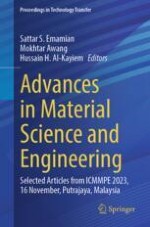2024 | Buch
Advances in Material Science and Engineering
Selected articles from ICMMPE 2023, 16-Nov, Putrajaya, Malaysia
herausgegeben von: Sattar S. Emamian, Mokhtar Awang, Hussain H. Al-Kayiem
Verlag: Springer Nature Singapore
Buchreihe : Proceedings in Technology Transfer
